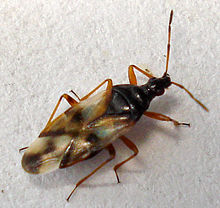Common flowerbug
| Common flowerbug | |
|---|---|

| |
| Adult of Anthocoris nemorum | |
| Scientific classification | |
| Domain: | Eukaryota |
| Kingdom: | Animalia |
| Phylum: | Arthropoda |
| Class: | Insecta |
| Order: | Hemiptera |
| Suborder: | Heteroptera |
| Family: | Anthocoridae |
| Genus: | Anthocoris |
| Species: | A. nemorum
|
| Binomial name | |
| Anthocoris nemorum (Linnaeus, 1761)
| |
The common flowerbug (Anthocoris nemorum) is a common minute pirate or flower bug.[1]
Distribution
[edit]The common flowerbug is found across Europe and the Palearctic to China.[2][3] It is common in Great Britain and Ireland.[1] In the Alps it is found to about 2000 meters above sea level.
Habitat
[edit]It more commonly inhabits lower moist, shaded vegetation than trees,[4] and especially nettles in the later half of the growing season.[5]
Description
[edit]
Anthocoris nemorum is typically 3–4 mm in length. These bugs have soft elongated flat bodies, with reflective forewings and black pronotum. The legs are mostly orange-brown, with small dark patches close to the tips of the femora. The antennae are mainly orange, with dark tips. In particular, antennal segments I and IV are usually dark, while II and III are pale with dark apices. The front wing is shiny transparent with a distinctive black dot in the center. The membrane shows an hourglass-shaped characteristic black spot at the wing tip. Nymphs of Anthocoris nemorum are dark brown or reddish brown.[4][5]
Biology
[edit]Adults can be found all year.[6] They are predatory insects, feeding on small insects including aphids and red spider mites.[1] A. nemorum lays its eggs inside plant leaves.[7] It has been used as a biological pest control since 1992, primarily to control Cacopsylla pyri.[8] It is capable of biting humans.[9]
References
[edit]- ^ a b c N Arlott; R Fitter; A Fitter (1994). Collins Complete Guide to British Wildlife. Collins. p. 224. ISBN 0-00-219212-8.
- ^ Natura Europaea
- ^ Bisby F.A., Roskov Y.R., Orrell T.M., Nicolson D., Paglinawan L.E., Bailly N., Kirk P.M., Bourgoin T., Baillargeon G., Ouvrard D. Catalogue of Life
- ^ a b Joseph Botting. "(Cimicidae) Anthocoris nemorum". British Bugs. Retrieved 3 July 2011.
- ^ a b Influential Points
- ^ iNaturalist
- ^ Stenberg, Johan A.; Lehrman, Anna; Björkman, Christer (2011). "Host-plant genotype mediates supply and demand of animal food in an omnivorous insect". Ecological Entomology. 36 (4): 442–449. doi:10.1111/j.1365-2311.2011.01285.x.
- ^ EPPO / OEPP (2008). "Biocontrol agents: Hemiptera/Heteroptera". EPPO/OEPP. Archived from the original on 2011-09-28. Retrieved 2011-07-03.
- ^ DA Burns (2010). Rook's Textbook of Dermatology, Volume 1, Eighth Edition (PDF). John Wiley and Sons. p. 38.23. ISBN 978-1405161695.
